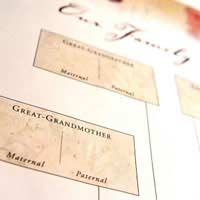Tracing the Female Line in your Ancestry

Most people trace the male line in the family when they go back and look at their family tree. That’s perfectly understandable, as the surname comes down the male side, so you’re essentially tracing the ancestors who held that name.
Once you’ve gone as far as you can with that, though, what can you do to keep enjoying genealogy? It can become an addictive pastime. Having gone back on the male side of your ancestors, why not look into the female side?
What You Can Learn
By going back in the family on your mother’s side, you’ll find another family history. The challenges will be exactly the same as going on your father’s side. In most instances you’ll take the maiden name and trace that in the same way as your surname.There is an alternative to this, which is to go from maiden name to maiden name, going back through time. This is more complicated, and it won’t give you the same kind of family narrative as following just one name, although you will have a chance to look more closely at the distaff part of history.
Following The Line
The techniques you learned when tracing the family history in the male surname will work for following the female line. You will still need the same records and to do as much research as you would for anything else.If you choose to follow maiden names you will still be able to go back, although once you’re back before 1837 and the advent of civil records it can become more problematic. In part that will be because you’ll be relying on parish records for baptism, marriage and death, and many of these are missing.
The more important factor to remember is that there are fewer records regarding women. In most instances they had no property of their own after marrying, as anything they owned became their husband’s property, so there will be no will as there’s nothing to bequeath or leave.
Marriage
Going back, many marriages were common law marriages and went unrecorded. Although it’s feasible to track a man by other means, such as tax rolls, tracing women is nowhere near as easy, due to their social status, which was, essentially, nonexistent.The simple lack of records pertaining to women is going to create a set of problems that can be difficult, if not impossible, to overcome. Where the women are of higher social status this won’t be too bad, as records of all members of the family will be kept, and their unions will be fully recorded and celebrated as they were as much commercial transactions as anything.
Class affects genealogy. That’s true for both genders. The lower the class, the fewer records there will be, and the more difficult your job as a genealogist. After looking at the family surname, it would make sense to progress to tracing the maiden name. Only after you have experience should you tackle jumping from maiden name to maiden name as it could be much more frustrating. Be prepared for several dead ends and to apply extrapolation and intelligent guesswork.
- Genealogy and a Criminal Past
- How to Deal With Conflicting Dates in Genealogy.
- How to Use Obituaries for Study
- Taking a Genealogy Course
- What's at the National Archive?
- Using the International Genealogical Index
- Using Local Libraries as Sources
- How Do You Know When You've Really Hit a Dead End?
- The Increase in Online Genealogical Resources
- Researching British Genealogy from Abroad
- The Importance of the 1911 Census
- Do You Need a Professional Genealogist?
- Latin In Church and Legal Records
- The Family Bible In Genealogy
- Genealogy And Military Records
- How To Find And Use Medieval Genealogy Information
- The Importance of the Protestation in Genealogy
- Checking Taxation Records for Family History Research
- Sharing The Results Of Your Genealogy Research
- Using Criminal Records For Family History Research
- How Museum Collections Can Help You In Genealogy
- Poor Law Records and Tracing Your Family Tree
- Surname Variations When Tracing Your Family Tree
- Tracing Ancestors Transported to the Colonies as Criminals
- Tracing Family History On The Female Side
- Using Geographical Maps to Trace Family History
- Using The Internet to Trace Your Ancestors
- Utilising Local History To Research Your Family Tree
- Genealogy and Medical Records


Re: Using Criminal Records For Family History Research
I’m looking for my dads criminal recorrds
Re: Using Criminal Records For Family History Research
Hi all i wanted to find out about my dad's past and nobody seems to know much about it or what he did.…
Re: Maiden Names in Genealogy
Looking for my fathers mother maiden name
Re: Genealogy and a Criminal Past
I am trying to find out about my father crime in 1992 or 1993 my father as pass away 1998 and I would like to find out why he got…
Re: Using Criminal Records For Family History Research
I am trying to find my biological father's police criminal record as I was abused as a child but have…
Re: Cremation Records and Tracing Your Family History
I am trying to find out where has my friends aunt Adelinda Diaz McMullen was cremated and who was her…
Re: Cremation Records and Tracing Your Family History
CAN SOMEONE PLEASE HELP ME WITH TRYING TO FIND OUT WHERE MY FATHER WAS CREMATED/BURIED IN KENT UK. I…
Re: What If You Have Asian Roots?
Ancestor Edward Albert Wells was born in Trichinopoly on 8 May 1833 to his father George Wells of the 54th Regiment at Foot and…
Re: How to Use Church Marriage Records to Trace Your Ancestors
It is still legal for first cousins to marry.
Re: Cremation Records and Tracing Your Family History
My sister finance was cremation and she stayed up by his bedside at Augusta university for days on out…